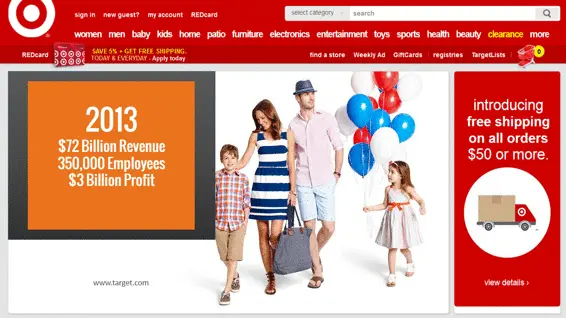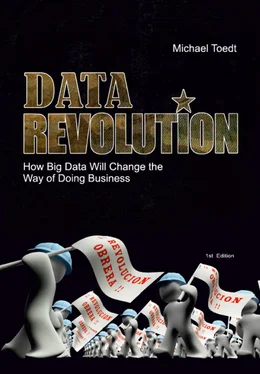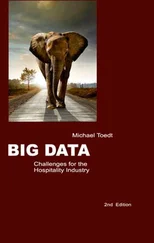Analysts at Target found out that women who purchase about 25 different products are potentially pregnant. This led to the creation of a pregnancy prediction model.

Figure 6: Traget - A “Big Data“ Success Story
“Take a fictional Target shopper named Jenny Ward, who is 23, lives in Atlanta and in March bought a cocoa-butter lotion, a purse large enough to double as a diaper bag, zinc and magnesium supplements and a bright blue rug. There’s, say, an 87 percent chance that she’s pregnant and that her delivery date is sometime in late August. What’s more, because of the data attached to her Guest ID number, Target knows how to trigger Jenny’s habits. They know that if she receives a coupon via Email, it will most likely cue her to buy online. They know that if she receives an ad in the mail on Friday, she frequently uses it on a weekend trip to the store. And they know that if they reward her with a printed receipt that entitles her to a free cup of Starbucks coffee, she’ll use it when she comes back again.” 22This is quite scary and the following true story a result of it:
“A man walked into a Target outside Minneapolis and demanded to see the manager. He was clutching coupons that had been sent to his daughter, and he was angry, according to an employee who participated in the conversation. “My daughter got this in the mail!” he said. “She’s still in high school, and you’re sending her coupons for baby clothes and cribs? Are you trying to encourage her to get pregnant?” The manager didn’t have any idea what the man was talking about. He looked at the mailer. Sure enough, it was addressed to the man’s daughter and contained advertisements for maternity clothing, nursery furniture and pictures of smiling infants. The manager apologized and then called a few days later to apologize again. On the phone, though, the father was somewhat abashed. “I had a talk with my daughter,” he said. “It turns out there’s been some activities in my house I haven’t been completely aware of. She’s due in August. I owe you an apology.” 23
As a result Target has shifted to a more subtle marketing approach. Promotions for products pregnant women would never buy are now added to the mailings. This makes the baby ads look more random. 24
2. 4. $750.000 for No Reason
In order to drive value from the available data, managers have to be able to ask the right questions, but also to understand the limitations. Analysts can provide beautiful charts, which suggest a highly valuable conclusiveness. Managers have to be aware that not the beauty of a chart should drive the decision, but the quality of the data and the analysis behind.
Like online stores, most hotels nowadays send so-called post-stay messages asking the guests for feedback. In many cases, the used tools collect data anonymously. When reviewing the reports provided by the web-based questionnaire tool, a hotelier saw the need to enhance his spa area and thus budgeted $750. 000 for an upgrade. He did this although the spa had been rated as one of the best spas in the country. During the annual strategy meeting an external data analyst questioned that budget decision. He tooks the anonymous data and linked the results to the individual guest profiles. Structured data has a much higher value and quality than unstructured data. It is curcial to link the guest profile to the feedback results, in order to generate sustainable results and to be able to draw the correct conclusions. This “obvious” requirement is, however, almost unknown and most managers lack the skills to question the delivered reports. In most companies there is literally a big wall between the customer profile and the questionnaire results.

Figure 7: A Wall between the Guest Profiles and Questionnaire Results prevent a Qualitative Analysis
With this in mind, the data analyst repeated the analysis after having linked the guest profile with the questionnaire results. He even went a step further and allocated the results to the different customer segments of the hotel and their overall contribution to the company’s financial success. By doing that, the analyst was able to show that 90% of the customers were happy with the spa area. The core target group of the hotel, the “Double-Income-No-Kids” segment, saw no need for an upgrade. The result was falsified by 10%, results from guests with kids, a customer segement the hotelier did not want to target anyways.
This example shows how easy it can be to drive exceptional value from data. Compared to Google, Wallmart or Target this story shows the importance of asking the right questions and undertanding that Big Data is no rocket-science.
Конец ознакомительного фрагмента.
Текст предоставлен ООО «ЛитРес».
Прочитайте эту книгу целиком, купив полную легальную версию на ЛитРес.
Безопасно оплатить книгу можно банковской картой Visa, MasterCard, Maestro, со счета мобильного телефона, с платежного терминала, в салоне МТС или Связной, через PayPal, WebMoney, Яндекс.Деньги, QIWI Кошелек, бонусными картами или другим удобным Вам способом.














